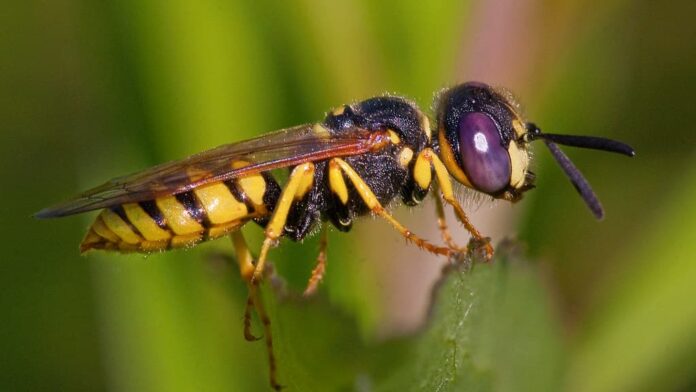The name itself is already quite intimidating; however, the bee wolf only preys on bees. This is why it also goes by the name bee hunters or bee-killer wasps. You probably know about many other common wasp species but this one is not so popular in the wasp family. This is why we are going to talk about them today so feel free to check them out.
1Appearance

A bee wolf grows up to about 1.7 centimeters which is quite large for a wasp. It has a dark thorax and a yellow abdomen with black stripes along with 6 legs and unfolded wings. This wasp has a yellow face and thick antennae, and it is reddish-brown at the back of its head. Among all species, the European bee wolf is probably the most recognized one due to its intimidating look. It has bold black and yellow markings on the abdomen, and males have trident-shaped markings between their bluish eyes. Females are larger, and they have a pale fade with a reddish stripe behind their eyes.
2Behavior

Bee wolves are solitary and predatory wasps that prey on bees, and the most famous species is the European beewolf. This species preys on honey bees, and they are huge pests for beekeepers. Outside bee farms, they also prey upon other bees such as American bumblebees and other bumblebee species. When hunting, a bee wolf stings the victim on the ventral surface where its venom can quickly paralyze major muscles. This is to make sure that prey remains alive while being unable to escape.
During the breeding season, adult females dig tunnels in the ground for nesting and that’s where they store the prey. Each tunnel is around 1 meter long, and there can be up to 34 lateral tunnels, each ending in a brood chamber. The mother bee wolf stores 1 to 6 honeybees in each brood chamber for her babies. Meanwhile, the territorial males mark twigs and surrounding objects with their pheromones to attract a female. After mating, males no longer have any role while the females do all the scary bits. Why scary, you may ask, because the larvae are carnivorous. This is why the mother bee wolf preys on bees to inseminate her eggs so that her larvae have food when they emerge.
3Feeding & Habitats

Adult bee wolves are herbivorous and they feed on nectar and pollen from flowers. However, bee wolf larvae are carnivorous so the mothers hunt bees to lay their eggs in. Visiting flowers also allows mother bee wolves to locate pollinating honeybees that they capture later as well. This wasp species lives in Europe, Northern Africa, and the United States. These wasps are common in coastal dunes and sandy areas of lowland heath where they can easily dig tunnels. Their main habitats are sloping sides of dry heaths and sand dunes because they help rain to drain away to avoid flooding.
Related Post: Most Dangerous Wasps In The World




